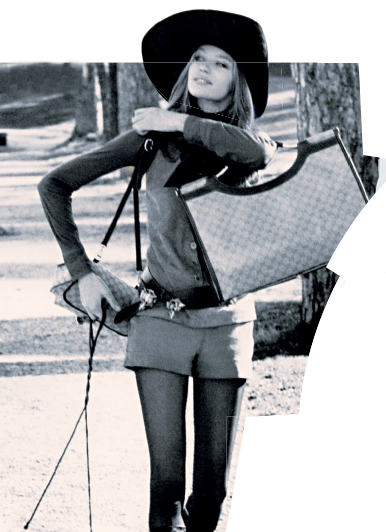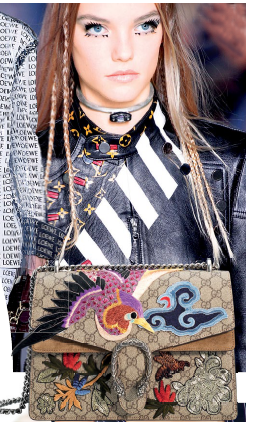From Gucci to Givenchy, designers are making a strong case for you to embrace logos once again.


From Gucci to Givenchy, designers are making a strong case for you to embrace logos once again

Remember that iconic’70s picture of Veruschka, who looked like a million bucks while taking a stroll through a park, dogs in tow? Yes, we were captivated by her radiant smile, but we were also drawn to a couple of Gucci bags, one slung over Veruschka’s right shoulder, the other sitting gingerly in the crevice of her elbow. The Italian brand’s signature “GG” pattern was splashed unapologetically across the bags. That perfect moment not only captured an archetypal and timeless style, but also showed how logos and patterns work within the confines of a modern, contemporary wardrobe. The proliferation of logos in modern fashion history can be traced back to as early as the middle of the 19th century, when Goyard’s Chevron pattern appeared on custom-made trunks which accompanied aristocrats and royalty on their travels. In 1896, Georges Vuitton created the Parisian leather goods powerhouse’s Monogram pattern in honour of his father, suffusing the House’s handcrafted luggage with an air of splendour. Since then, such logos and patterns have become symbolic of society’s highest strata.

Logos hit their peak of popularity in the late’80s and into the’90s, with every designer brand worth their salt shouting out in gold, silver, sequins, diamanté and brilliant neon. Ironically, the minimalism movement of the ’90s, driven by the likes of Helmut Lang, Jil Sander and Calvin Klein, kick-started the decline of logo mania by rejecting blatant displays of wealth and bling-ed out excess. Fast forward to today, and studies conducted by luxury behemoths have found that Chinese shoppers—the country has been slated to have the largest number of luxury shoppers with LVMH having reported 28 percent of its sales as coming from Asia—are becoming more discerning in their buys. They are opting for stealth parades of wealth by investing in pieces that are unique, vouch for high quality and yet remain understated. The aspirational value of logos has decreased over time, becoming the antithesis of good taste with its blatant branding.

Could this be the death knell for logos? Well, not quite. Logo mania will always be a point of contention in fashion. Like it or not, the trend has been returning to the runways like waves washing on the same shore, each time sparking debates on what constitutes good or bad taste. But, fashion in the 21st century has been witnessing a reversal of fortunes for logo mania yet seen.

The signs are all there-bubbling under the surface of graphic sporty sweaters emblazoned with Kenzo’s name from 2012. Even Hedi Slimane got into the act at Saint Laurent by introducing a new iconography based on the brand’s classic Cassandre “YSL” logo. Under Slimane’s Midas touch, the sublime Toile Monogram dripped with an unmistakable French nonchalance and it became chic once more to tout your love for the brand with bold metal wordings. Alexander Wang continued the discussion in his spring/ summer 2014 collection by “carving” his name as a brash pattern on skirts or laser cut-outs on cropped tops and leather dresses. For Wang, the only way forward for logo mania was to utilise it as a rebellious celebration of individuality rather than an indicator of “status.”

This unabashed focus on the individual is one of the biggest reasons for logo mania registering on fashion’s radar again. With millions of people on Instagram lapping up every move/pose/post by powerful social media stars, logos are an easy way for brands to increase visibility. Social media’s grip on fashion is democratic and viral (followers are only hampered by access to Wi-Fi and 3G, not dollars or cents), which means we’ll continue seeing an influx of more logos to “Like.”

The spring/summer 2016’s catwalks yielded the boldest, loudest and most convincing turnout of logos by far. The biggest difference? They’re now made ultra cool, and worn by fashion’s new squad of It girls (and boys) who aren’t apologetic about making a statement. Nicolas Ghesquière offered a glimpse of what the future has in store for logo mania when he brought Vuitton’s respected Damier and Monogram Canvas to new frontiers. Against futuristic LED displays and sliding screens, Ghesquière re-appropriated the patterns into futuristic-looking panels on tailored leather vests, biker jackets and bags, putting a conceptual and intellectual spin to the Parisian Maison’s most famous emblems.

Over in Milan, Gucci’s Alessandro Michele wholeheartedly embraced the brand’s heritage when he took over as Creative Director. And one of the many ways he’s managed to accomplish that is by reinterpreting Gucci’s famous “GG” pattern on a host of covetable must-buys that are anything but vulgar. For his debut, Michele made the interlocking “GG” sign hip again with something as simple as a belt (those who have followed Gucci in the ’90s from its Tom Ford days would recall his famous GG logo belt on the hips of Madonna and supermodels Amber Valletta and Trish Goff). Michele then proceeded to decorate the Dionysus, the brand’s new It-bag crafted from the recognisable webbed pattern, with all sorts of lovely floral embroidery. This season, the shaggy-haired designer continued his ode to a bygone romance by fashioning a luxurious trench coat from the pattern. His take is clearly archival and vintage, giving Gucci this “lost treasures from the attic” vibe, which ties in with the current trend for Bohemia and all things rustic.


On the flip side, spring also saw bad boy Riccardo Tisci jumping on the logo bandwagon—albeit in an altogether flashier manner. His branding is unashamedly showy. Tisci updated Givenchy’s visual vocabulary with a new print that combines the brand’s name with big bold stars, making its appearance first on Givenchy’s men’s runway show. Tisci is determined to make this a House signature, even using it as a leitmotif for the upcoming pre-fall collection. Is this the birth of a new fashion favourite? Only time will tell. But as past trends have shown, it’s the fastest (and most profitable) way for brands to show well... their brands. It’s brand advertising—which you as the consumer actually pays for. Whether you choose to wear logos for wealth, acknowledgment, individuality, allegiance, or simply because you actually like it, for now, it’s proof that it doesn’t take much to dress like a superstar. So go ahead and make it your #squadgoal. We promise we won’t judge.
























